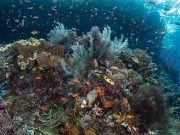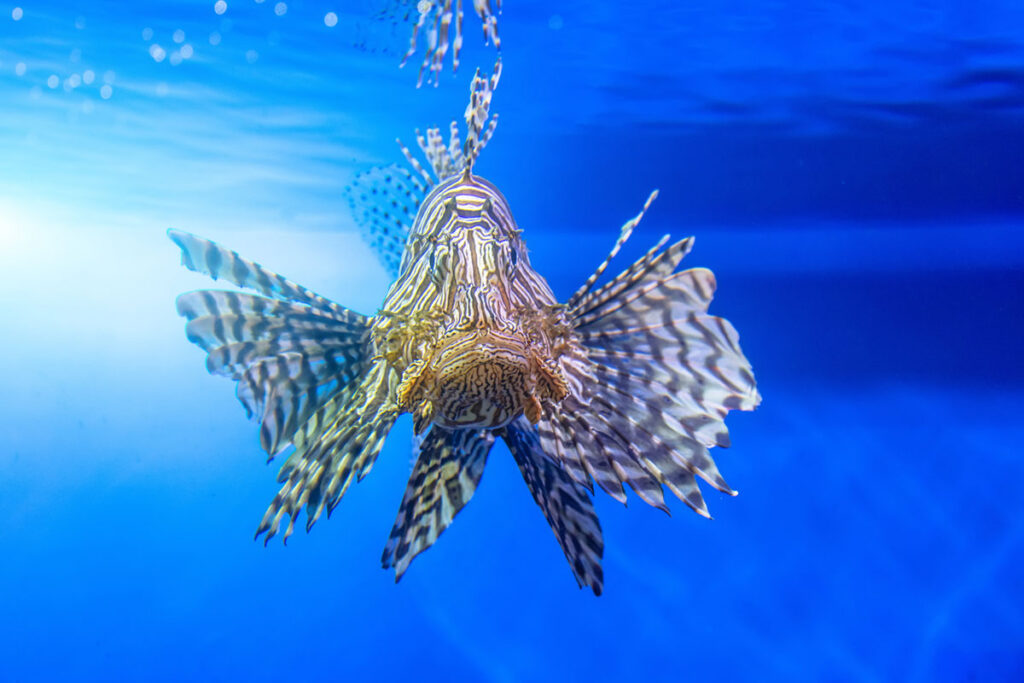Researchers from Wageningen University and Research, the Netherlands, have published a comprehensive study on the invasion of lionfish in the Mediterranean Sea, highlighting a rapid spread and the potential ecological impacts.
 Image: Tim Nicholson
Image: Tim NicholsonPublished in the open-access journal NeoBiota, the research shows the lionfish species Pterois miles has significantly expanded its territory in the Mediterranean since the invasion began around ten years ago. The invasive species has established presence in the eastern Mediterranean, with observations now extending to colder waters previously thought to be unsuitable for the species.
Reaching the Mediterranean from the Red Sea, the lionfish species Pterois miles and Pterois volitans are regarded as the most successful invasive fishes in marine ecosystems, with the capacity to drastically affect local fish communities and biodiversity in invaded areas.
Lionfish are generalist predators and impact ecosystems by preying extensively on local fishes, including endemics of high conservation value. As they are unaccustomed to lionfish, native prey species usually do not flee from this new predator.
“After years studying these predators, I find it amazing how they can easily adjust to so many different environments and be successful in areas that are so different from the ones where they evolve,” says lead author Davide Bottacini.
“It is always impressive to see how such a flamboyant and–to us–conspicuous predator can approach its prey without being noticed,” he continues.
As the largest enclosed sea on earth, the Mediterranean is a unique ecosystem. It is a highly biodiverse basin home to more than 11,000 animal species, some of which are found nowhere else in the world. Genetic studies revealed that lionfish found in the Mediterranean originate from the Red Sea and likely entered through the Suez Canal.
Through a detailed review of existing scientific data, the researchers identified gaps in our understanding of the lionfish’s interactions with Mediterranean ecosystems and have proposed future research directions to address these challenges. Such information provides insights vital for biodiversity conservation and will have practical implications for policy makers aiming to devise sound and efficient mitigation plans.
The study also highlights the crucial role of citizen science initiatives in tracking and reporting sightings of lionfish, providing valuable data that supports ongoing research efforts. Such community involvement is essential for enhancing understanding of the invasion dynamics and devising effective control measures.
History of Lionfish in the Mediterranean
The first lionfish ever reported in the Mediterranean was caught by a trawler off the coast of Israel in 1991 and identified as P. miles. No more lionfish were reported until 2012, when two specimens were captured in Lebanon. Soon after, lionfish were reported in Turkey, Cyprus, Greece and Italy. Lionfish were first considered invasive in the Mediterranean in 2016, when they were reported in large groups and numbers in Cyprus. Lionfish have now established and successfully spread through a large part of the eastern Mediterranean and continue to expand their range westwards.
The northern Red Sea is inhabited by another lionfish species that is biologically and ecologically similar to P. miles; Pterois radiata. P. miles and P. radiata often occur together on the coral reefs of the northern Red Sea and in comparable abundances. Interestingly, P. radiata has never established in the Mediterranean. The scientists postulated that P. radiata may be less invasive than P. miles due to its smaller size and slightly higher degree of habitat and diet specialisation
Tracking the Invasion
The researchers contacted dive centres on the Mediterranean coast to ask whether they see lionfish during their dives and if they remember the first year that they saw them. Sightings were reported by 82 dive centres, mostly in the eastern Mediterranean. Lionfish were seen by almost every dive centre that responded from Israel, Cyprus, Turkey, Greece and Albania. In just two years, lionfish have expanded their invasive range in the Mediterranean at two fronts: the northern Aegean Sea and the southern Adriatic Sea.
What do do?
Culling tournaments were organised in the Mediterranean soon after the start of the invasion. Although culling can be effective at the local scale, eradication of lionfish from their invaded ranges is considered impossible for three reasons.
- The effort of having to actively spear-fish for lionfish is high and limits the areas that can be covered in culling tournaments
- Culling initiatives are restricted to relatively shallow waters (0–40 m), while invasive lionfish can live in much deeper waters, with large aggregations spotted even beyond 300 m of depth
- Lionfish adjust to the hunting pressure posed by spear-fishers by becoming more wary towards approaching divers, decreasing the effectiveness of repeated culling initiatives in the same areas. The researchers conclude that culling should, therefore, be seen as a containment measure, rather than a definitive solution and should be focused on areas of high ecological interest.
Further Reading
Bottacini D, Pollux BJA, Nijland R, Jansen PA, Naguib M, Kotrschal A (2024) Lionfish (Pterois miles) in the Mediterranean Sea: a review of the available knowledge with an update on the invasion front. NeoBiota 92: 233–257. https://doi.org/10.3897/neobiota.92.110442
Lionfish begin invasion into Mediterranean Sea: Cyprus already colonised. Jill Studholme, 2016
Image credits:
- Lionfish: Tim Nicholson
- lionfish: Papichev Aleksandr/DepositPhotos

















